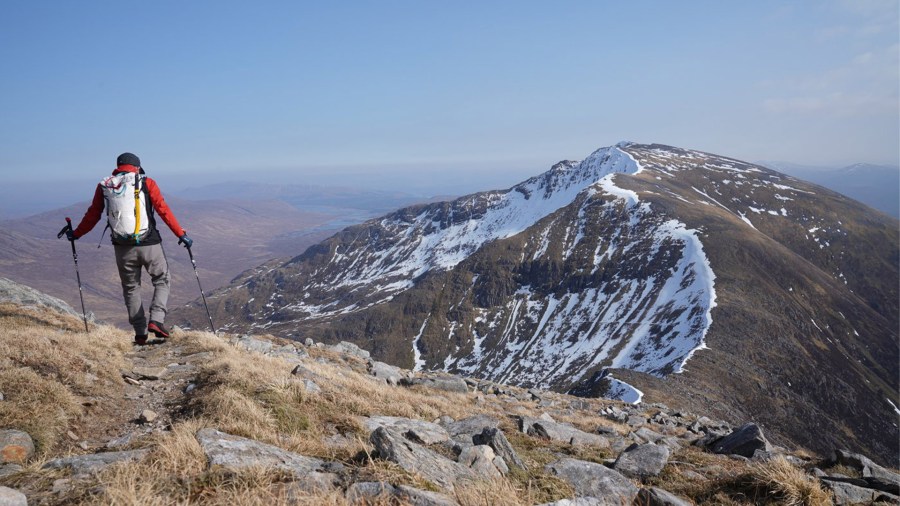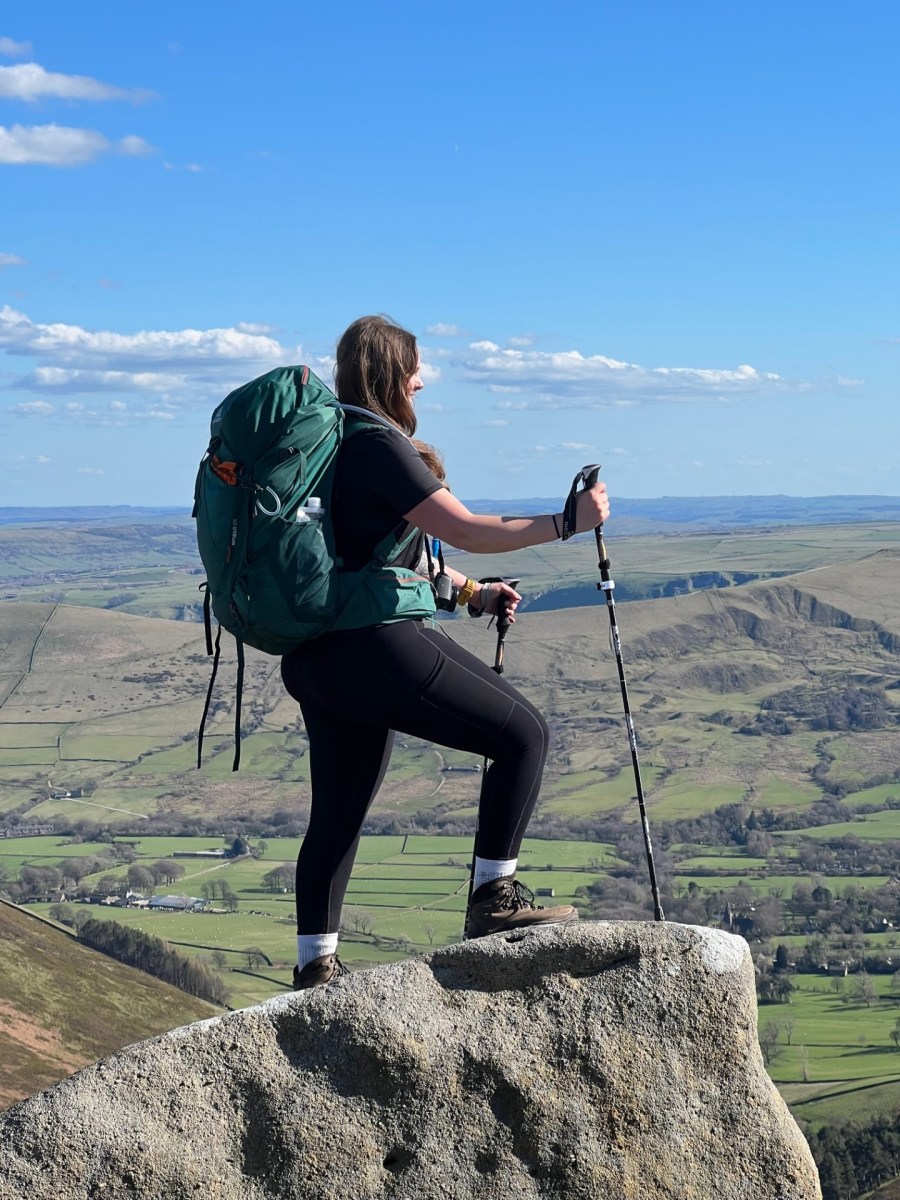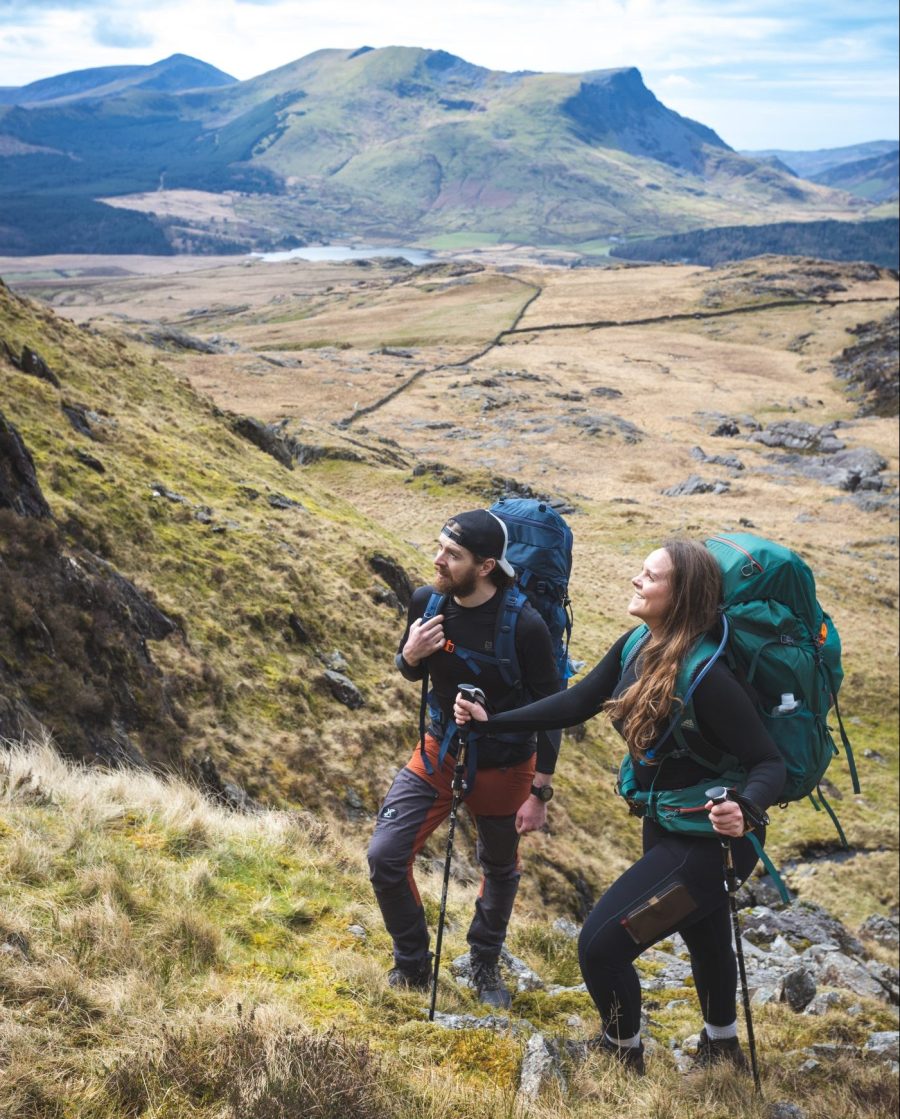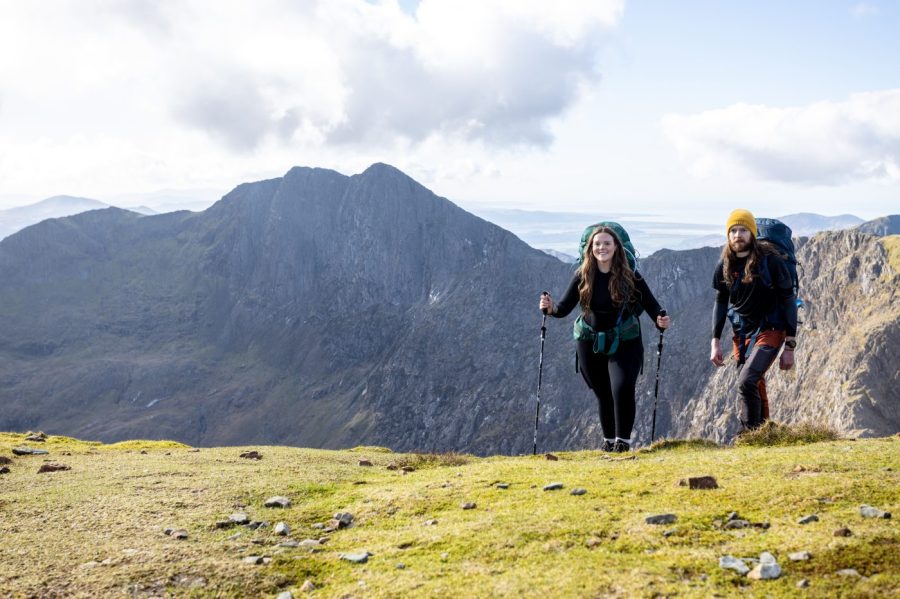Hiking poles are your perfect trekking companion, helping to provide stability and support while maximising efficiency, rhythm and posture. Here we explain why.
You might have some preconceptions about the use of hiking poles. You may think they’re just for people who have leg injuries or ailments or those who haven’t quite reached their peak hill fitness. Actually, hiking poles are so much more. Especially for multi-day backpackers, they’re an essential bit of kit designed to help protect you, support you, help you find your flow – whatever pace that might be – and keep you walking for longer.
Main image: The author using hiking poles to scale the scree side of Crib Goch in Eryri/Snowdonia. | Credit: Benjamin Cannon.
The Great Outdoors‘ expert gear reviewers have tested a variety of the best hiking poles on the market if you’re ready to invest. Beforehand, here we answer some of your questions on all things hiking pole.
- What are hiking poles?
- Why are hiking poles important for hiking?
- Who needs hiking poles?
- When should you use hiking poles?
- Do poles help in adverse conditions?
- Are there any disadvantages?
- How to use poles
What are hiking poles?
Hiking poles are, simply put, handheld (and adjustable and packable) poles designed to stabilise and support you while walking, maximising efficiency, rhythm and posture. They are often built with a grip for your hands, a loop that goes over your wrist and a tough, durable tip.
The are primarily designed to reduce the significant stress on your feet, knees, legs and back while walking by allowing you to take some weight through your arms, thus spreading the stress evenly across the whole body.
Why are hiking poles important for hiking?
If that’s not enough for you, hiking poles can also help keep you safe. As the terrain you walk gets more and more mountainous, you’ll find yourself increasingly likely to be hiking on uneven, rocky and loose ground. Even on lower level walks, you might come across tricky paths and steep grass slopes. While they cannot prevent slips and falls 100% of the time, walking with two poles gives you better balance and stability as you take your next step.

TGO gear tester, David Lintern using a pair of poles to descend. Credit: David Lintern.
For backpackers, hiking poles are particularly important in spreading some of the weight from the heavy load to your upper body, taking some of the pressure off your lower body and feet. As an added bonus, innovations in the construction of ultralight backpacking tents have also seen hiking poles incorporated into tent pitching systems, saving you the weight of tent poles.
Contrary to preconceptions, hiking poles can actually be useful for those travelling fast and on even ground, too. You’ll often see long distance runners using lightweight poles. This is largely because they can offer both propulsion from the use of your upper body, and aid good rhythm, which makes moving through mountains more efficient.
Indeed, hiking poles have also been shown to improve your gait, enabling you to stand straighter and take longer strides. This can also change your perception on the amount of effort you’re exerting. Even though you’ll burn more calories by engaging your upper body, using the hiking poles as a trekking aid make you feel as though you’re working less hard by giving your legs a little break.
You might not notice the benefits immediately, but over time, your joints and posture will thank you.
Who needs hiking poles?
Not everyone ‘gets on’ with poles. Sometimes, this is simply because some walkers like to keep their hands free at all times for that snack or a selfie. Occasionally, you’ll hear hiking pole naysayers share negative preconceptions or claim they don’t work. This is often down to simple misuse (more on how to avoid that later).
Despite the myth or the image you might conjure in your mind, hiking poles are not just for those who are ‘over the hill’. In fact, they help all kinds of walkers get to the top of said hill and back down in a safe and efficient manner that will keep their bodies healthy and mobile for longer.
Those with movement disorders, lower body ailments or chronic illness often find the greatest benefit from use of hiking poles. I personally started using poles during a period of physio for an ongoing hip injury. I’ve never looked back. The reassurance they offer on days when my leg is feeling less strong or on longer excursions carrying a heavy pack is now an essential part in helping me completing happy and successful hikes.

Hiking poles: the Tic Tac of the trekking world.
Credit: Francesca Donovan
Even a walker with enviable hill fitness should consider using hiking poles. Even when you travel fast and light, joints and muscles are still at risk of repetitive strain. Poles will alleviate some of that pressure – and even give your legs a boost from your upper body strength to help you move faster.
When should you use hiking poles?
This part is really up to you and deducing the time to use poles comes with both common sense and experience. For example, any hillwalker can see a steep scramble requiring both hands is probably a good time to strap the poles to your pack and gets hands-on.
Likewise, the benefit of hiking poles on steep descents will become quickly clear as they give added anchor points and relief from pressure caused by gravity-laden bumps and jolts which occur as you move down a mountain. They also can act as a break, giving your leg muscles a rest.
I find they come into their own on steady, grassy ascents when the legs tire quickly. If you have plotted a route with a number of these, you’ll be praising your poles by the end.
A general rule of thumb is that hiking poles become more practical as the terrain you walk gets more uneven. What you deem to be tricky terrain is a personal line in the proverbial sand and depends on your pack weight, gait, fitness, sure-footedness and experience. Develop good navigation and route planning skills, and you’ll not only come to understand when you will benefit from use of poles, you’ll ideally be able to preempt the moment by pinpointing uneven terrain on a map and pull out your poles as a preventative measure before you find yourself in discomfort.
Other situations in which hiking poles can be both a help or hinderance depending on your preference include exposed ridgelines and scree runs.
Do poles help in adverse conditions?
It’s not just about terrain. I have personally found my hiking poles to be a great reassurance and aid in various adverse walking conditions. In unexpected high winds, especially in exposed areas, they allowed me to stand straighter and keep propelling forward thus avoiding the aches and pains caused by stooping and bending double against the elements.
A pair of poles can also come in very handy when tackling river and bog crossings. They allow you to gauge depth pre-crossing and also, vitally, help you stay upright during. This also applies to the trail breakers who find themselves in deep snow. In drifts, hiking poles might be cumbersome. On easy, low-level terrain when ice axes are overkill, poles can be an effective accompaniment to crampons to keep you stable on rambles when the snow has compacted.
What are the disadvantages of hiking poles?
Hiking poles can be expensive additions to your kit list, though there are affordable options on the market from the likes of Trekmates and Alpkit.
For those looking to keep pack weight down, poles may also seem a burden. But there are plenty of incredibly lightweight poles on the market by manufacturers such as Silva, Leki and Komperdell but these do come at a higher price.

To pole or not to pole?
Credit: Benjamin Cannon
Hiking poles can also seem intimidating to the uninitiated. I was given my first pair as a gift and they sat in my pack for months before I caved and was, inevitably, converted. “What if I use them incorrectly and look silly?” I would say.
Well, fear not. Below, we’ve included a handy guide on how to hike with poles.
How to use hiking poles
Learn to adjust
Firstly, adjust your walking poles to fit you. When you hold your walking poles by the grip with the tip touching the ground, your elbows should be bent in a 90-degree angle by the waist.
If you’re walking up an incline, it helps to adjust your poles a little shorter so they don’t get in the way. Likewise, letting them out onto a longer setting on the downhills will allow the pole to serve as an additional touch point without requiring you to stretch down.
Get a grip
As you walk, maintain a good but not tight grip and engage your shoulders. Hold your poles between your thumb and forefinger. Different pole manufacturers offer different grip materials and shapes, with some options designed for men and women while other remain unisex. Find one ergonomic to your hand.
Swish and flick
Loop the wrist strap around your wrist. It’ll keep the poles secure and prevent your from having to grip onto the pole tightly all day, causing your hands to tire. On uphills, you can use the wrist loop as leverage without having to grip at all, preventing further forearm exertion.
This loose grip also allows to to ‘flick’ the pole forward as you walk, requiring minimal effort.
In motion
The best practice for using poles is mimicking your natural arm swing as you walk. So, take a step forward with your right foot. You’ll notice your left arm swings in a manner that offers natural balance. This is the precursor to the essential ‘opposite arm’ rule while using trekking poles. If your left leg is stepping forward, your right pole moves forward – and vice versa. This keeps you balanced and prevents a swaying gait.
Planting the pole
Many walkers who are new to using poles make the mistake of simply letting them ‘dangle’ around their wrists, only using them lightly as they hike. But getting the full benefit of using hiking poles means putting a degree or force or pressure through them. If you’re walking uphill or on the flat, this means planting them behind you and firmly pushing on them to gain propulsion. When walking downhill, it means placing them in front of you as you walk and putting your weight on them to absorb some of the stress on your legs.
READ MORE: If you’re ready to take a chance on poles, you can find advice on how to choose the right hiking poles for you – and whether you should use one or two – from our gear team at The Great Outdoors.








